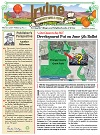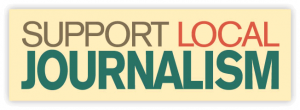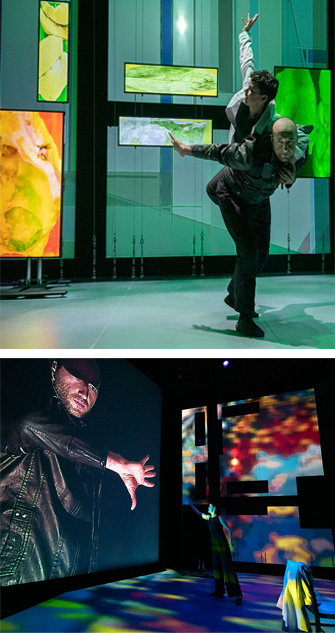
Scenes from “Reading Frankenstein” (Photo Credit: Steve Zylius/UCI)
A long, l-o-n-g time ago — prior to masks and physical distancing — back in 2019, I attended an original play called Reading Frankenstein. It was staged in UCI’s Experimental Media and Performance Lab (xMPL).
UCI Arts Professor Antoinette LaFarge worked with Annie Loui and Jim Fallon on the adaptation of Mary Shelly’s classic Frankenstein. The setting of the 2019 version tells the story of a life scientist, working with genetic engineering, who creates a monster that runs amok. I’ll admit that I have always been a fan of horror movies, so this was right up my alley.
With only two actors, the stage sets from the 2019 version are sprawling images that were entirely computer-generated. Combined with a compelling story, the play was more than a simple update on the original. It sent you out the door with nagging questions about where we are today in this “info-pocalypse” of false information … and gasping for a breath of fresh mental air.
Recently, we were able to arrange a face-to-face meeting — outdoors over cups of coffee at Irvine’s Eureka! restaurant to discuss her work at UCI and her new book. I began by asking a simple question: “Do you refer to yourself as an artist or a writer?” Antoinette responded by saying: “I don’t sit happily with either one by itself. I work best where images and languages meet and tangle.”
I found Antoinette to be a font of clearly spoken, thought-provoking ideas. Educated during that nearly forgotten era prior to the computer-frenzied world we now live in, today Antoinette has a comprehensive command of computer arts media, including all of its many offshoots.
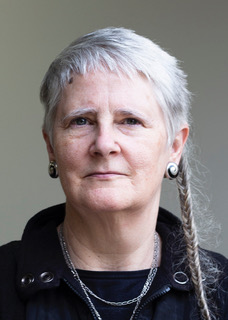
Antoinette LaFarge (Photo Credit: Kyle Welker)
Antoinette’s resume includes an extensive list of shows, exhibits, and mixed-reality performances and installations that have been viewed around the world. In 1999, Antoinette joined the Department of Art at UCI. Working with Robert Nideffer, she co-founded the Electronic Art and Design program. Today, Antoinette is the director of the program, teaching both undergraduate and graduate classes. Approximately 200 students sign up for her lecture class, Art 1C “Art in Context.” In this maelstrom of digital media, Antoinette has become a lighthouse.
Antoinette refers to what she calls her “secret lens” through which she views and expresses her creativity. She told me: “My beat is virtuality and its discontents.” (This may need some clarification. It’s a sign on a path which leads to her recently published book, Sting in the Tale.)
Here’s what Antoinette refers to as her back story: “All of my adult life, I’ve been interested in forgery. If you think about it, forgery is the last taboo in art. So where does the truth lie?”
Sting in the Tale is Antoinette’s magnus opus. Completed after 10 years of effort, it is a compendium of “Fictive-art.” (New concept, I know.) Defined by Antoinette, Fictive-art is “Art with a fiction at the center of it.” This is on the signpost indicating the intellectual stream that flows throughout her new book.
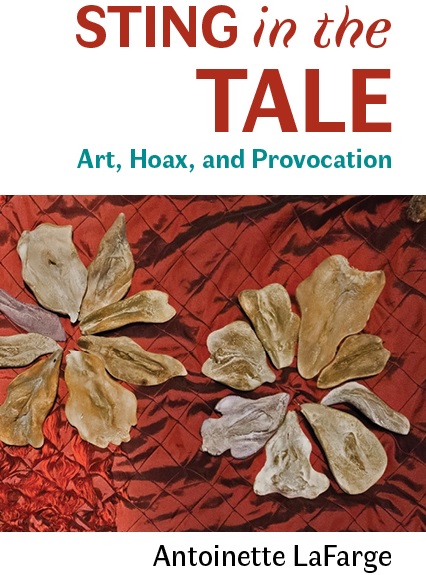 Sting in the Tale expresses a dilemma that Antoinette pursues: “Where does authenticity arise?” The book is an in-depth illustrated compendium of “fictive art,” which includes example works and their creators — from 19th century pioneers to today’s ingenious practitioners. It is a virtual playland ride through imaginative settings and artists’ concepts. Most of all, it’s ideas. Even after a brief sampling of the contents, I’m reminded of her observation: “The position for uncertainty is very uncomfortable. When you are uncertain, you test things more thoroughly.”
Sting in the Tale expresses a dilemma that Antoinette pursues: “Where does authenticity arise?” The book is an in-depth illustrated compendium of “fictive art,” which includes example works and their creators — from 19th century pioneers to today’s ingenious practitioners. It is a virtual playland ride through imaginative settings and artists’ concepts. Most of all, it’s ideas. Even after a brief sampling of the contents, I’m reminded of her observation: “The position for uncertainty is very uncomfortable. When you are uncertain, you test things more thoroughly.”
Nope. I’m not going to define “fictive art.” But allow me to list a few sections from her book which will hint at landmarks in this arena: The Museum of Jurassic Technology; The Mars Patent, which is a website where one can commission works of art to be installed on the planet of Mars; The Museum at Purgatory; Institute for the Study of Perpetual E_Motion, which describes how the time-space continuum is warped through the activity of particles known as ‘rumerons’; The New Society for Universal Harmony; and The Institute of Militronics & Advanced Time Interventinality, where time-travel uniforms are displayed. Reading a chapter at a time is a romp. They remind me of why I bothered to collect and save old comic books.
In Antoinette’s own apt description of Sting in the Tale, she says: “The point of my book is that doubt is more important than belief.”
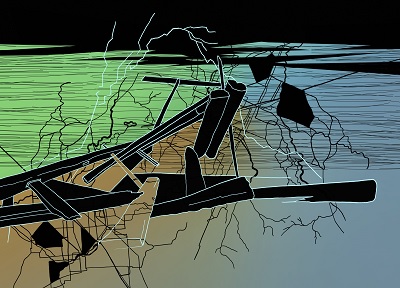
Digital Print, “Abandoned Bones” by Antoinette LaFarge & Christel Dillbohner
Looking ahead, I ask: “What are you currently working on?” Always ready with a fresh new direction, Antoinette is scheduled to launch a fall show at the Fresno City College Art Gallery. It is an exhibition of four-handed drawings and paintings done by Antoinette in collaboration with Bay Area artist Christel Dillbohner. The two artists worked together, often simultaneously, in an improvisational manner, without any pre-arranged plan.
Any discussion about what lies ahead for Antoinette reflects in her apt self-observation: “I’ve never had a problem with the ‘blank-canvas’. I go where my curiosity prompts me. I’ve always had more ideas than I knew what to do with.”
Although it’s not even on the horizon today, I want to buy tickets to her next play!
Below are a few links to learn more about Antoinette and upcoming events at UCI:
To register for Antoinette’s October 5th Sting in the Tale book discussion event, click here.
To learn more about Antoinette and her book, Sting in the Tale, click here.
To review the calendar of events at UCI’s Claire Trevor School of the Arts, click here.
- Two Violinists, One Shared Mind - November 11, 2023
- Life in a House of Music with Zara B’Far - September 8, 2023
- Meet Susan Boettger & Family: Life in a Real-Time Music Festival - June 9, 2023

